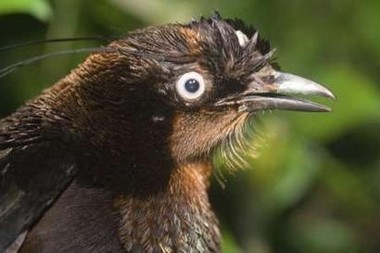
February 7, 2006
The discovery of a "Lost World" in New Guinea is the breaking story of the day. I guess you just never can tell what you’re find if you look on the upper slopes of the Foja Mountains, in the easternmost and least explored province of western New Guinea, humm?
Due to a technical breakdown here last night when Cryptomundo went offline, I wasn’t able to post on this exciting development. In the meantime, I see this morning, the internet is screaming about the "hundreds of species" found.
One of the best items on the findings is at Boing Boing; they have a good overview and photograph of one of the new bird species discovered.

Click here (if you are a New York Times registrant) for their slide show of the "Lost World" species.
I’m especially interested in the mammals discovered, and so here’s what The Independent has to say about those:
Mammals
Forty species of mammals were recorded. Six species of tree kangeroos, rare elsewhere in New Guinea, were abundant and the scientists also found a species which is new to Indonesia, the golden-mantled tree kangeroo. The rare and almost unknown long-beaked echidna, or spiny anteater, a member of a primitive group of egg-laying mammals called monotremes, was also encountered. Like all the mammals found in the area, it was completely unafraid of humans and could be easily picked up, suggesting its previous contact with man was negligible.
The prize is to have found a new large mammal for Indonesia, the Golden-mantled Tree Kangaroo (Dendrolagus pulcherrimus), formerly known from only a single mountain in neighboring Papua New Guinea.
Islands are special little Petri dishes, which can hold many surprises.
In another lost world of sorts, the island of Madagascar, the new discoveries of lemurs continue. A newly revised version of Lemurs of Madagascar has been published, enlightening us to the diversity of lemurs still be verified from that biological treasure trove.
The book covers the story unfolding there, according to a press release from Conservation International (CI): "Written by a team including CI President Russell A. Mittermeier and Malagasy primatologists Jonah Ratsimbazafy and Rodin Rasoloarison, the book updates a first edition published in 1994 with subsequent research and genetic studies on lemurs that identified 10 new species and reclassified nine others as separate species (emphasis added)….Other co-authors are William R. Konstant; Edward E. Louis; Olivier Langrand; Jorg U. Ganzhorn; Serge Rajaobelina; Ian Tattersall, and David M. Meyers. Illustrations are by Stephen D. Nash. "
Taking a cue from birding field guides, the new lemur field guide has a lemur-sighting list in an effort to launch a primate-watching industry. The idea is that tourists will carry around the handbook, then spot and identify the 71 species of lemurs that live on the island, and make their own "life lists" of sightings.
The light-hearted appeal to travel about the island to view all the known lemurs is given against a sobering message in this new field guide: 16 species of lemurs have disappeared from Madagascar.
By the way, I wonder if there is room at the bottom of the lemur-sighting list to make notes about the kalanoro? Or will we learn if any unknown animals were noted by the scientists on Foja Mountains that weren’t discussed, yet, in all this breaking news?
About Loren Coleman
Loren Coleman is one of the world’s leading cryptozoologists, some say “the” leading living cryptozoologist. Certainly, he is acknowledged as the current living American researcher and writer who has most popularized cryptozoology in the late 20th and early 21st centuries.
Starting his fieldwork and investigations in 1960, after traveling and trekking extensively in pursuit of cryptozoological mysteries, Coleman began writing to share his experiences in 1969. An honorary member of Ivan T. Sanderson’s Society for the Investigation of the Unexplained in the 1970s, Coleman has been bestowed with similar honorary memberships of the North Idaho College Cryptozoology Club in 1983, and in subsequent years, that of the British Columbia Scientific Cryptozoology Club, CryptoSafari International, and other international organizations. He was also a Life Member and Benefactor of the International Society of Cryptozoology (now-defunct).
Loren Coleman’s daily blog, as a member of the Cryptomundo Team, served as an ongoing avenue of communication for the ever-growing body of cryptozoo news from 2005 through 2013. He returned as an infrequent contributor beginning Halloween week of 2015.
Coleman is the founder in 2003, and current director of the International Cryptozoology Museum in Portland, Maine.
Filed under Books, Breaking News, CryptoZoo News, Cryptozoology, Expedition Reports, Eyewitness Accounts, Forensic Science, New Species